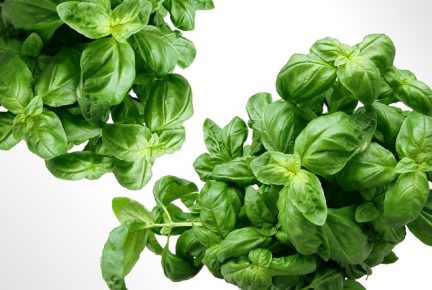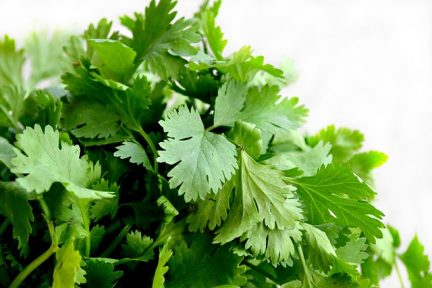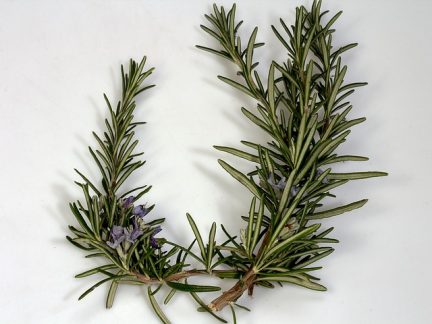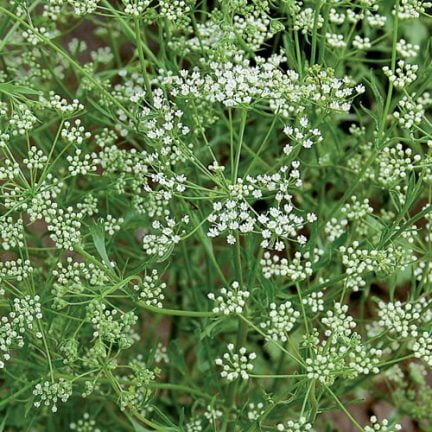Herbs and Spices
Importance of Herbs and Spices to Oregon
Herbs and spices are small industries in Oregon. 33 herb operations produce a total of 33,653 lbs of harvested herbs. Some herbs that grow in Oregon are basil, lavender, and mint.
History of Herbs and Spices
Herbs and spices have been used since ancient times. The first use of spices dates back to the Middle East in 5000 BC. Throughout history, spices have been valuable for trading between different people and populations. Herbs can be used for flavoring and preserving food, as fragrances or smells, or for medicinal purposes.1
Varieties of Herbs and Spices

Basil
Basil has light-green silky leaves with a strong, sweet smell. Basil is common in many cuisines throughout the world such as Italian, Thai and Vietnamese. Basil is sensitive to cold weather, so it should be grown in the spring. Basil will continue to cultivate leaves as long as the leaves are removed from the plant.2

Cilantro
Cilantro is a green herb with soft, spiky-edged leaves. Cilantro is usually used as a topping for savory dishes. When planting cilantro, make sure to put it in a location with plenty of sunlight, such as a kitchen window sill! To thrive, cilantro needs to be planted in rich, well-drained soil.3

Rosemary
Rosemary is a perennial plant, meaning it continues to live and grow for several years. Rosemary has dark green leaves that are shaped like needles and smell very strong. Starting in the spring, rosemary bushes produce small purple-blue flowers. In addition to adding flavor to food, Rosemary provides oils that are used to make perfumes, shampoos, and soaps.4
When growing rosemary, seeds should be planted indoors 8 to 10 weeks before the last spring frost. Rosemary grows best with sunlight and well-draining soil.

Anise
Anise is a herb cultivated for its fruit called aniseed. Aniseed tastes similar to licorice and is often used to flavor pastries. Anise can be identified by its small yellow-white flowers that are grouped in clusters called umbels.5
Anise needs to be planted in a location that will get full sun and wind protection. This plant is the most successful in well-drained soil. Anise seeds should be started in the greenhouse and transplanted outside 8 weeks after planting. Anise will need 120 days, free of frost, to grow to full maturity.6

German Chamomile
Chamomile is one of the most popular herbs in the Western world. Chamomile has been used as medicine for thousands of years to treat conditions such as troubles falling asleep, sore throats, stomach aches and more. Chamomile is a small flower with a yellow center and white petals. Chamomile looks very similar to daisies!7
German chamomile is an easy plant to start from seed because it self-seeds, meaning it produces its own seeds that fall into the soil to create more flowers. Chamomile seeds should be started indoors and kept under a light. The light will cause the seeds to germinate, or sprout, in seven to fourteen days. German Chamomile does not require much water for growth and it is best to allow the plants to dry out between waterings.8
Life Cycle of a Herb Plant
Herbs can be either annual (completing their life cycle in one year), perennial (growing for more than one season), or biennial (a flowering plant that takes two years to complete its life cycle). With annual herbs such as basil, cilantro, anise and chamomile, you must replant them each year from a seed or as a plant start. However, with perennial herbs, such as rosemary, you can enjoy the same plant for many seasons.9
Herb and Spice Harvest
Herbs and spices can be grown in a small backyard garden or a large-scale farm that provides a higher yield. Harvest timing and equipment are specific to the herbs being produced. Harvested herbs often require immediate special handlings such as drying, separation of leaves or seed, and temporary packaging to preserve its color, aroma, flavor, appearance and sanitary condition.10
Pests and Diseases
Herbs are susceptible to many pests and diseases because they are delicate plants with small leaves. One pest that can have a large impact on the plants and leaves are aphids. Aphids produce a sticky substance that speeds up the process of mold growth.

Uses for Herbs and Spices
Fun Facts About Herbs and Spices!
- Long ago, people used to believe that herbs had magical powers such as the power to heal, to make you smart, strong and even fall in love.11
- Rosemary can live up to 10 years in ideal conditions!
- Herbs can be grown in the wild, in a garden or flower bed, or even in your house.
- Ancient Greek and Roman doctors believed that basil would grow only if its cultivators sowed the seeds while screaming and shouting.12
Vocabulary Terms
Annual
A plant that completes its life cycle in one year and must be replanted the next season.
Biennial
A flowering plant that takes two years to complete its life cycle.
Cuisines
A style or method of cooking characteristic of a particular country or region.
Germinate
The process by which a seed or spore begins to grow into its mature form.
Perennial
A plant that continues to live and grow for several years and does not need replanting each season.
Plant starts
A young plant that grows from a seed, also called a seedling.
Self-seeds
A plant that releases seeds into the soil to reproduce.
Transplants
A plant that has been grown from seed in a tray and then planted into a field.
Umbels
A flower cluster with a flat or curved surface, often characteristic of the parsley family.
Yield
A measurement of production harvested per unit of land area.
